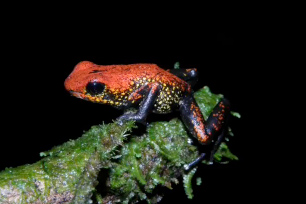A spectacular poison dart frog on the edge of extinction in the wild has been afforded temporary protection by warring drug gangs in Colombia’s Chocó region, reports ProAves.
The La Brea Poison Frog (Oophaga occultator), a colorful species only documented by scientists in 1975, has suffered from unsustainable collection for the pet trade, severe deforestation for coca cultivation, and aerial spraying for coca eradication, resulting in a substantial population decline. But the species has clung to life in a deforested landscape along the Saija River in Colombian Pacific coast in part due to conflict between three armed groups—the FARC, the ELN and Los Rastrojos, a paramilitary group. The fighting has kept collectors out of the area, protecting the frog.
 La Brea Poison Frog (Oophaga occultator). Image from ProAves |
The species, which is known for its singing as well as its stunning coloration, was recently photographed by members of ProAves. The frog hasn’t been sighted in the wild by researchers in nearly 20 years.
But while confirmation of the survival of the species is welcome news, the indigenous people who live in the region may be faring worse, according to ProAves. Some 600 Emberá, displaced by the conflict, are living in a camped communal house in Timbiquí.
ProAves says a new threat to the Emberá and the frog may come from illegal gold miners moving up the Saija River.
Related articles

(11/03/2009) Reducing Emissions from Deforestation and Degradation (REDD), a climate change mechanism proposed by the U.N., has been widely lauded for its potential to simultaneously deliver a variety of benefits at multiple scales. But serious questions remain, especially in regard to local communities. Will they benefit from REDD? While much lip-service is paid to community involvement in REDD projects, many developers approach local communities as an afterthought. Priorities lie in measuring the carbon sequestered in a forest area, lining up financing, and making marketing arrangements, rather than working out what local people — the ones who are often cutting down trees — actually need in order to keep forests standing. This sets the stage for conflict, which reduces the likelihood that a project will successfully reduce deforestation for the 15-30 year life of a forest carbon project. Brodie Ferguson, a Stanford University-trained anthropologist whose work has focused on forced displacement of rural communities in conflict regions in Colombia, understands this well. Ferguson is working to establish a REDD project in an unlikely place: Colombia’s Chocó, a region of diverse coastal ecosystems with some of the highest levels of endemism in the world that until just a few years ago was the domain of anti-government guerillas and right-wing death squads.
Largely unexplored rainforest slated to be leveled for gold mining in Colombia

(08/13/2009) Serrania de San Luca is a rainforest-covered massif rising to 2,300 meters (7,500 feet) in northern Colombia. Despite being little-explored and containing several endangered species, the forest is threatened by industrial gold mining operations, according to the local conservation group ProAves. Already the forest has been reduced to 10 percent of its original 2.5 million acres due to agriculture, small-scale mining, and other human impacts. Now, the Colombian government has granted large concessions to AngloGold Ashanti, a gold mining company out of South Africa which has been criticized by the Human Rights Watch for allegedly aligning itself with locally armed gangs in the Democratic Republic of Congo.
Illegal drug use destroys rainforests
(11/18/2008) Colombian officials have re-iterated their claim that cocaine use in rich countries is driving deforestation in Colombia, reports The Guardian.
Cocaine use is destroying the Amazon rainforest, says new campaign
(05/26/2008) A new campaign has linked cocaine consumption in Europe and the United States to destruction of the Amazon rainforest in Colombia.














